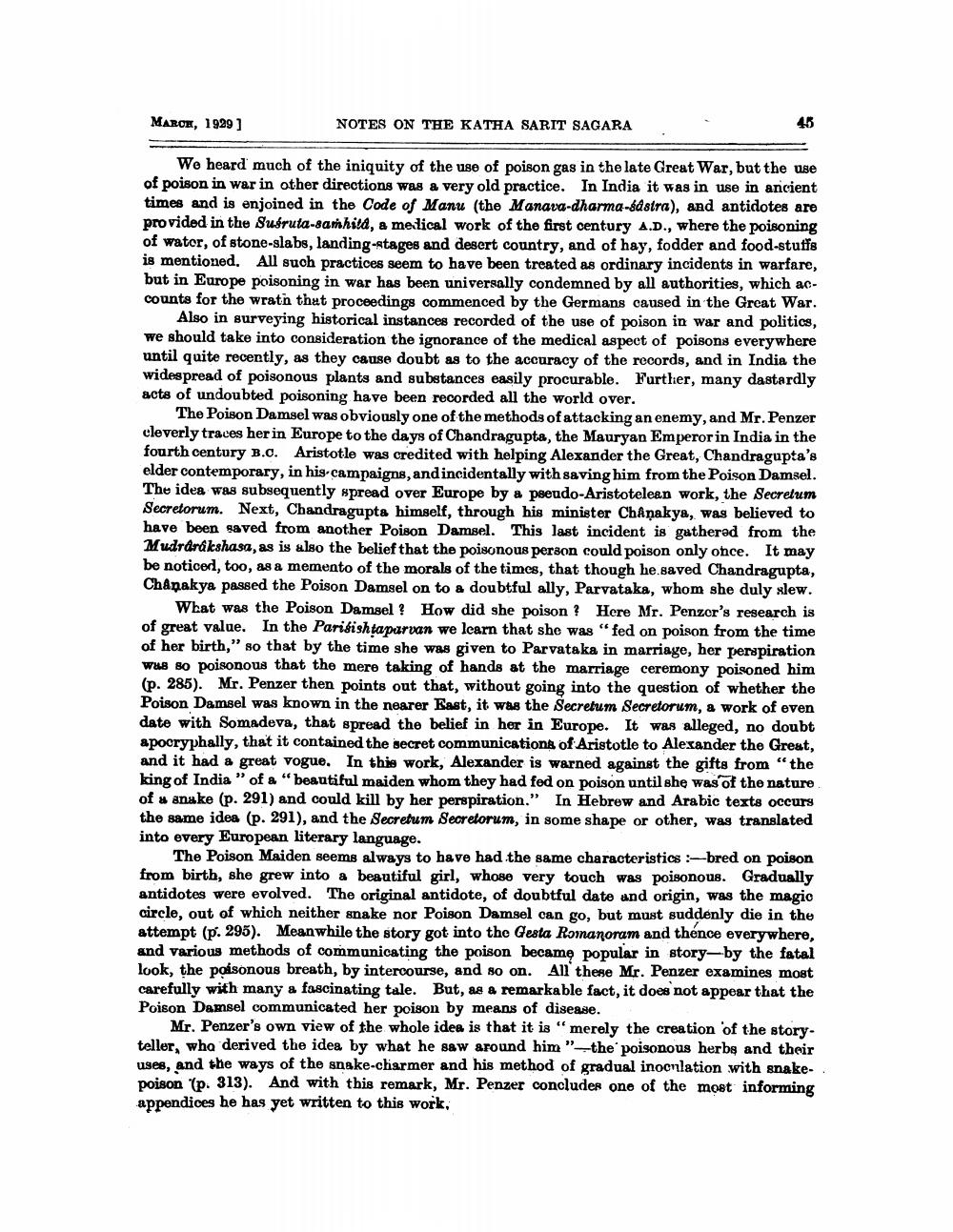________________
MAROK, 1929]
NOTES ON THE KATHA SARIT SAGARA
We heard much of the iniquity of the use of poison gas in the late Great War, but the use of poison in war in other directions was a very old practice. In India it was in use in ancient times and is enjoined in the Code of Manu (the Manava-dharma-8dstra), and antidotes are provided in the Sufruta-samhita, a medical work of the first century A.D., where the poisoning of water, of stone-slabs, landing-stages and desert country, and of hay, fodder and food-stuffs is mentioned. All such practices seem to have been treated as ordinary incidents in warfare, but in Europe poisoning in war has been universally condemned by all authorities, which accounts for the wratin that proceedings commenced by the Germans caused in the Great War.
Also in surveying historical instances recorded of the use of poison in war and politics, we should take into consideration the ignorance of the medical aspect of poisons everywhere until quite recently, as they cause doubt as to the accuracy of the records, and in India the widespread of poisonous plants and substances easily procurable. Further, many dastardly acts of undoubted poisoning have been recorded all the world over.
The Poison Damsel was obviously one of the methods of attacking an enemy, and Mr. Penzer cleverly traces her in Europe to the days of Chandragupta, the Mauryan Emperor in India in the fourth century B.C. Aristotle was credited with helping Alexander the Great, Chandragupta's elder contemporary, in his campaigns, and incidentally with saving him from the Poison Damsel. Thu idea was subsequently spread over Europe by a pseudo-Aristotelean work, the Secrelum Secretorum. Next, Chandragupts himself, through his minister Chanakya, was believed to have been saved from another Poison Damsel. This last incident is gathered from the Mudrårákshasa, as is also the belief that the poisonous person could poison only once. It may be noticed, too, as a memento of the morals of the times, that though he saved Chandragupta, Chanakya passed the Poison Damsel on to a doubtful ally, Parvataka, whom she duly slew.
What was the Poison Damsel! How did she poison ? Here Mr. Penzor's research is of great value. In the Paribishta parvan we learn that she was "fed on poison from the time of her birth," so that by the time she was given to Parvataka in marriage, her perspiration WHS so poisonous that the mere taking of hands at the marriage ceremony poisoned him (p. 285). Mr. Penzer then points out that, without going into the question of whether the Poison Damsel was known in the nearer East, it was the Secretum Secretorum, a work of even date with Somadeva, that spread the belief in her in Europe. It was alleged, no doubt apocryphally, that it contained the secret communications of Aristotle to Alexander the Great, and it had a great vogue. In this work, Alexander is warned against the gifts from "the king of India ” of a "beautiful maiden whom they had fod on poison until she was of the nature of & anake (p. 291) and could kill by her perspiration." In Hebrew and Arabic texts occurs the same idea (p. 291), and the Secretum Secretorum, in some shape or other, was translated into every European literary language.
The Poison Maiden seems always to have had the same characteristics bred on poison from birth, she grew into a beautiful girl, whose very touch was poisonous. Gradually antidotes were evolved. The original antidote, of doubtful date and origin, was the magic circle, out of which neither snake nor Poison Damsel can go, but must suddenly die in the attempt (p. 295). Meanwhile the story got into the Gesta Romanoram and thence everywhere, and various methods of communicating the poison became popular in story-by the fatal look, the possonous breath, by intercourse, and so on. All these Mr. Penzer examines most carefully with many a fascinating tale. But, as a remarkable fact, it does not appear that the Poison Damsel communicated her poison by means of disease.
Mr. Penzer's own view of the whole idea is that it is "merely the creation of the storyteller, who derived the idea by what he saw around him "-the poisonous herbs and their uses, and the ways of the snake-charmer and his method of gradual inocnlation with snakepoison (p. 313). And with this remark, Mr. Penzer concludes one of the most informing appendices he has yet written to this work,




